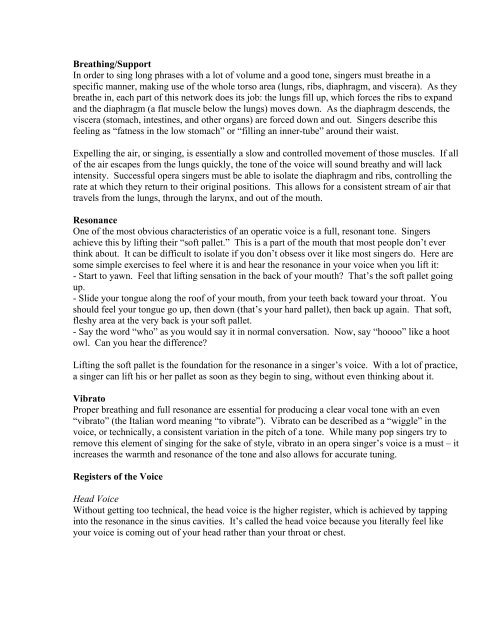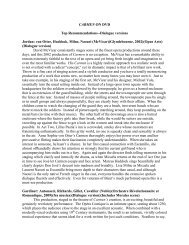Opera In The Know - Florentine Opera
Opera In The Know - Florentine Opera
Opera In The Know - Florentine Opera
Create successful ePaper yourself
Turn your PDF publications into a flip-book with our unique Google optimized e-Paper software.
Breathing/Support<br />
<strong>In</strong> order to sing long phrases with a lot of volume and a good tone, singers must breathe in a<br />
specific manner, making use of the whole torso area (lungs, ribs, diaphragm, and viscera). As they<br />
breathe in, each part of this network does its job: the lungs fill up, which forces the ribs to expand<br />
and the diaphragm (a flat muscle below the lungs) moves down. As the diaphragm descends, the<br />
viscera (stomach, intestines, and other organs) are forced down and out. Singers describe this<br />
feeling as “fatness in the low stomach” or “filling an inner-tube” around their waist.<br />
Expelling the air, or singing, is essentially a slow and controlled movement of those muscles. If all<br />
of the air escapes from the lungs quickly, the tone of the voice will sound breathy and will lack<br />
intensity. Successful opera singers must be able to isolate the diaphragm and ribs, controlling the<br />
rate at which they return to their original positions. This allows for a consistent stream of air that<br />
travels from the lungs, through the larynx, and out of the mouth.<br />
Resonance<br />
One of the most obvious characteristics of an operatic voice is a full, resonant tone. Singers<br />
achieve this by lifting their “soft pallet.” This is a part of the mouth that most people don’t ever<br />
think about. It can be difficult to isolate if you don’t obsess over it like most singers do. Here are<br />
some simple exercises to feel where it is and hear the resonance in your voice when you lift it:<br />
- Start to yawn. Feel that lifting sensation in the back of your mouth? That’s the soft pallet going<br />
up.<br />
- Slide your tongue along the roof of your mouth, from your teeth back toward your throat. You<br />
should feel your tongue go up, then down (that’s your hard pallet), then back up again. That soft,<br />
fleshy area at the very back is your soft pallet.<br />
- Say the word “who” as you would say it in normal conversation. Now, say “hoooo” like a hoot<br />
owl. Can you hear the difference?<br />
Lifting the soft pallet is the foundation for the resonance in a singer’s voice. With a lot of practice,<br />
a singer can lift his or her pallet as soon as they begin to sing, without even thinking about it.<br />
Vibrato<br />
Proper breathing and full resonance are essential for producing a clear vocal tone with an even<br />
“vibrato” (the Italian word meaning “to vibrate”). Vibrato can be described as a “wiggle” in the<br />
voice, or technically, a consistent variation in the pitch of a tone. While many pop singers try to<br />
remove this element of singing for the sake of style, vibrato in an opera singer’s voice is a must – it<br />
increases the warmth and resonance of the tone and also allows for accurate tuning.<br />
Registers of the Voice<br />
Head Voice<br />
Without getting too technical, the head voice is the higher register, which is achieved by tapping<br />
into the resonance in the sinus cavities. It’s called the head voice because you literally feel like<br />
your voice is coming out of your head rather than your throat or chest.








